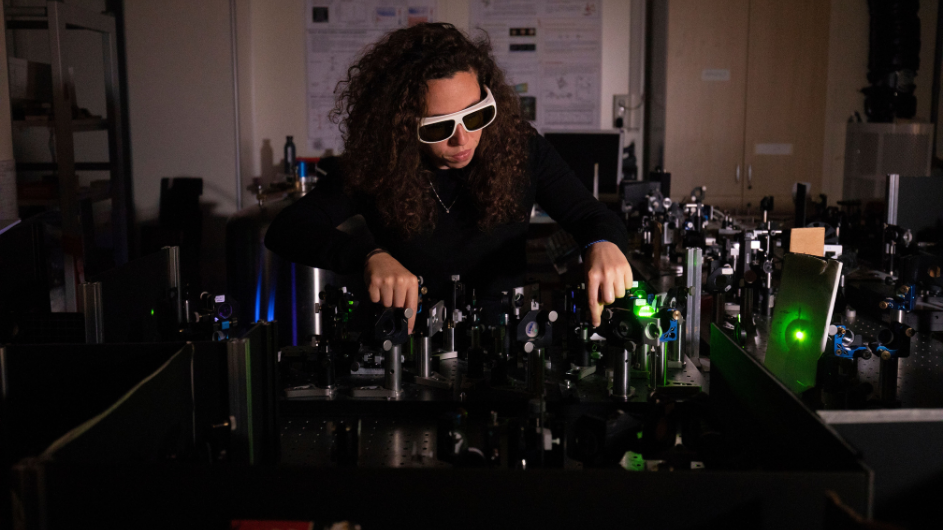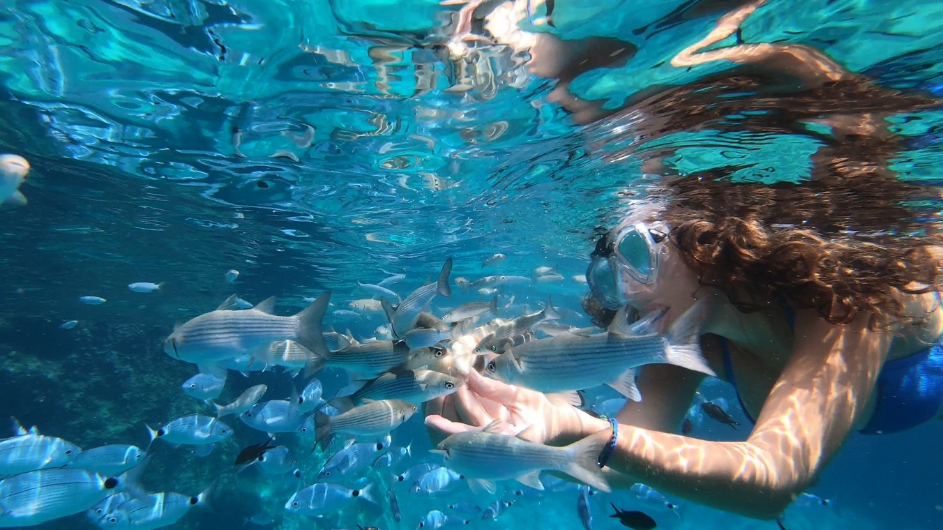Quantum Q&A With Postdoc Chiara Trovatello
The recipient of the 2022 Couillaud Prize is back in New York and has her sights set on building a super tiny new laser to advance quantum optics research.

Engineer and physicist Chiara Trovatello first visited Columbia as a Marie Curie RISE Fellow in 2019, when she spent six months probing nonlinear optical phenomena in quantum materials with Jim Schuck’s lab in the Department of Mechanical Engineering. While here, she revealed for the first time that super-thin 2D materials can amplify light over sub-nanometer lengths.
“That was a major moment for me,” said Trovatello. She had spent a month designing and building a setup to get a material just three atoms thick to amplify light. One evening, she had a spark of an idea for a tiny tweak. The next day, there was light. “You can’t help but feel so lucky to be the first person to see something like this,” she said.
The plan was always to come back after she completed her PhD at Politecnico di Milano in March 2020, but the pandemic had other ideas. Two years later, she’s finally returned to the Schuck Lab as a postdoc where, with the support of the 2022 Couillaud Prize from Coherent Inc. and the Optica Foundation (OPTICA), she’ll continue pushing quantum materials to new optical limits.
We recently asked her about her plans for the prize, what goes into a laser, and what she’s up to when she isn’t thinking about engineering.
Tell us about your research interests?
I study the nonlinear optical properties of 2D materials—essentially, how atomically thin crystals interact with light, which is made of quantum particles called photons.
We can exploit these nonlinear interactions to create novel light sources, like frequency-tunable compact lasers, and to generate photon pairs that are correlated with each other through a quantum phenomenon called entanglement. Entangled photons are a basic building block of quantum information and communication technologies.
What makes this work so promising, and challenging?
In addition to some remarkable electronic and optical properties, 2D materials are one million times thinner than a millimeter. That makes them extremely suited for next-generation nanotechnology, and you can make much smaller devices than with larger, bulkier options. For example, the typical crystals used to generate entangled photons currently are millimeter or even centimeter-thick—you can see and hold these in your hands.
However, the overall efficiency of 2D materials is still low, due to how thin they are. We need to figure out how to engineer them at the nanoscale to produce stronger light—what we call increasing the nonlinear optical gain—while preserving their compact, on-chip-integrable size.
What are your plans for the Couillaud Prize?
With the Couillaud Prize and my colleagues in the Schuck lab, we are trying to increase the nonlinear optical gain from the material we studied while I was visiting in 2019, which was a type of transition metal dichalcogenide (TMD) called molybdenum disulfide. We want to use it to create a new, miniaturized laser.
What goes into making a laser?
Lasers amplify light—that is, they increase its intensity, using specific active media. Different kinds of gases, liquids, and solids can be used as light amplifiers, but these are all macroscopic. Miniaturization has dominated the world of electronics in recent years, enabling the realization of powerful consumer devices such as smartphones and tablets. This trend is now moving to the laser world and the field of photonics.
I plan to use an engineered TMD as the extremely compact gain medium for next-generation tunable nano-lasers. Right now, we are figuring out the conditions that will let us build a laser from such small components. If we can create that device, we will be one step closer to designing and creating an entangled photon source at the nanoscale.
What will that mean for technology?
This research will improve on-chip nonlinear devices. Such integrated light sources have potential applications in secure quantum communications, entirely new digital protocols and technologies, and may enable significant advances in computing speed—all with drastically lower energy use.
When you aren’t in the lab, what are you up to?
I like photography, and I really enjoy playing the guitar, although unfortunately I wasn’t able to bring it with me to New York!
In the summer, I love to dive. I grew up in Syracuse, Italy, near the sea, where there’s spectacular diving—lots of big, beautiful fish, sea stars, and other marine animals. I like to film while I dive, especially when I can visit the same site regularly. Fish can be surprisingly interactive animals! They’ll start to get comfortable around you, and some will even let you feed them from your bare hands.
I’ve found that my best ideas don’t usually come to me at work, so it’s nice to dive and play guitar as much as I can and just let things come to me.

Any advice for others interested in quantum science and engineering?
Perseverance is really important in research. Most days are spent studying, thinking, planning, and setting up your experiment. Sometimes you succeed, other times you fail, but every day is a learning experience.
Eventually, you can get things to work, and when that happens science happens. That’s the beauty of fundamental research: you are trying to answer questions that no one has answered before, and when you do, it pays everything back.
